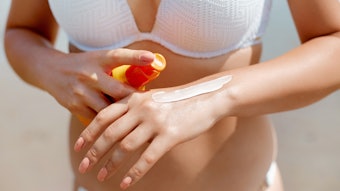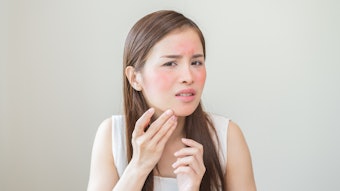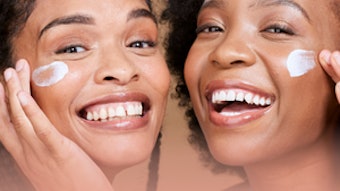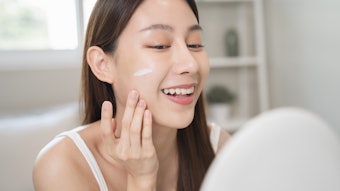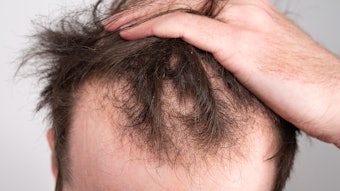In clinical medicine, percutaneous penetration has become a diagnostic reality, with evidence of the unintentional transfer of active gender hormones, i.e., estrogen and testosterone, from dosed to unknowing individuals occurring in clinical trials via interpersonal contact.1–4 Transfer depends on many factors, such as type of exposure, amount of transdermal hormone applied, number of exposures, applied area, transfer area, timing and frequency of contact.5 This unintentional transdermal hormone transfer may cause a clinically significant hormone imbalance and side effects such as cardiovascular events or masculinization in adults and precocious puberty or virilization in children.5–10
It is also possible that the transdermal transfer of applied hormones is of clinical relevance to personal care products. An estimated 1–3% of the population is allergic to a cosmetic product or ingredient contained therein.10 These allergies are mainly to fragrance chemicals such as hydroxy-isohexyl-3-cyclohexene carboxaldehyde and preservatives such as methyldibromo glutaronitrile, but also include emerging allergens such as UV filters and nail acrylates.11 Clinically significant reactions may range from mild sensory irritation to a clear allergy resulting in a positive patch test.11 Similar to transdermal hormone transfer, allergic dermatitis from a cosmetic product depends on many factors including composition of the product, concentration and purity of the ingredients, condition and site of application, contact duration and application frequency.11 The present overview examines the evidence validating transdermal hormone transfer and explores the potential for percutaneous penetration of cosmetic ingredients to cause dermatologic disease not only in the dosed individuals, but also in their interpersonal contacts.
Transdermal Hormone Transfer
Transdermal topical estrogen and testosterone transfer from dosed individual to interpersonal contacts such as spouses, children and friends can occur. Recent in vivo human experiments have sought to quantify this phenomenon. Wester et al. studied the potential for transfer of a 0.16 g [14C]-estradiol gel formulation from six postmenopausal women to unknowing volunteers.1 Transfer was attempted through 15 min of direct ventral forearm contact between the women and volunteers, and rubbing the forearms 10 additional strokes. The dosed site was then covered with a protective sleeve for 24 hr. Approximately 2.3% of the applied estradiol dose was recovered from skin washings and 4.1% from the sleeve, showing that transfer occurred between dosed subjects and the volunteers. Additionally, excess chemical remained, i.e., was not fully absorbed, on the skin during the 24-hr application period, and thus was available for interpersonal transfer.1 Also using estradiol emulsions, Taylor and Gutierrez reported significant transfer between 14 postmenopausal women dosed with a 1.74-g transdermal estradiol emulsiona and male partners by vigorous skin-to-skin rubbing for 2 min.2
The same transfer phenomenon was observed with male gender hormones when the two testosterone gels available for clinical use in the United States were tested. In a seven-day gel study,3 three groups of healthy men were dosed with 10 g of a 1% testosterone gelb followed by 15 min of vigorous skin-to-skin leg contact with female partners. On day one, the mean time-average testosterone concentrations (Cavg) in female partners increased threefold (18 ng/dL) and by day seven, the Cavg increased fourfold to sevenfold, exceeding the normal female range of 10–55 ng/dL. Additionally, two exposed women developed maximum testosterone levels of 250 ng/dL and 350 ng/dL.3
In another trial,4 30 healthy men applied 100 mg of a different testosterone gelc to their abdomen and engaged in 15 min of skin rubbing with female partners, after which the serum testosterone concentrations in female partners were found to increase fourfold. The researchers then applied 100 mg of the testosterone gel to the arms and shoulders of 24 healthy men who engaged in 15 min of skin rubbing with female partners. Despite showering immediately after exposure, serum testosterone concentrations in female partners still increased fourfold.4 Results from the above studies indicate that interpersonal transfer of topical estrogen and testosterone products can occur.5 Similar concepts may hold true for other topical products, including cosmetic items.
Cosmetic Allergy Relevance
Hypersensitivity to cosmetic products has been documented. Willis et al. conducted an epidemiological study on skin sensitivity via a self-assessment questionnaire of 3,300 women and 500 men, to which 57% of female and 31.4% of male responders reported past history of an adverse reaction to a personal care product;12 the response rate was 62% for women and 52% for men. Of note, hypersensitivity symptoms, such as burning and irritation, were more common in the respondents that regarded themselves to have more sensitive skin.12 Another prospective study involving 1,075 patients attending Swedish patch test clinics reported that 47.3% (54.2% women, 30.8% men) of patients acknowledged current or past adverse reactions to cosmetics and skin care products.13 The authors concluded that the incidence of adverse skin reactions due to cosmetic products may be underestimated.13 In relation, a structured protocol has been offered to improve the reporting of adverse reactions to skin care products.14
Allergic reactions have occurred after application of deodorants, perfumes, skin care products, makeup, hair dye, shampoo, conditioner, lip balm and nail polish.11, 15–17 While allergic contact dermatitis is a more common condition, immunologic contact urticaria has been reported after use of products containing ingredients such as balsam of Peru, benzyl alcohol, butylhydroxytoluene, benzophenones, parabens, polyethylene glycols and lanolin alcohol.11 These cosmetic hypersensitivity reactions, representing 0.3% of all dermatology patients and 5.4% of all contact dermatitis cases, are important to clinicians.11 Additionally, there is a distinct cosmetic allergy entity to consider when patients present with contact dermatitis after interpersonal transfer.
As detailed in Table 1,18–22 dermatitis caused by secondary exposure to family members such as spouses or partners, termed connubial contact dermatitis, has been specifically reported after use of fragrances, hair dye materials, benzoyl peroxide, topical psoriasis treatments,23 anti-fungal treatments,24 azathioprine and ketoprofen.25, 26 With emerging data on adverse reactions from topical hormone transfer, it is plausible that direct connubial transfer of percutaneously absorbed cosmetic ingredients could similarly lead to unwanted effects. Further studies may explore whether cosmetic allergy in connubial hypersensitivity is significant enough to cause clinically relevant dermatologic disease.
Discussion
The existing clinical trials benefit from improvement in trial design to reflect more precise interpersonal exposure potential. In previous cases of transdermal hormone transfer from adult to adult or parent to child, it is unlikely that brief controlled rubbing or direct contact without movement alone caused all of the observed effects. Transfer more likely occurred through daily interactions and contact required for hugging, playing or cuddling.5 For this reason, transfer studies based on exaggerated contact times may be more capable of reflecting real life exposures.5
Different anatomic sites may also affect percutaneous penetration, and thus potential for interpersonal transfer, to different degrees. Regional variation of percutaneous absorption is described with the genitals as the anatomic site with greatest absorption, followed by the face, trunk, arms and legs, in decreasing order.27, 28 Thus, connubial contact dermatitis following transdermal transfer becomes an important clinical consideration. The potential for transfer is further complicated by application site of the dosed individual and contact site of the recipient. For example, to what degree would transfer occur if a mother applied perfume and held her infant’s face against her skin? And how much transfer does occur during daily connubial interactions? As new technology is able to explore potential for percutaneous absorption based on intrinsic properties of the skin, studies on transfer of topically applied hormones may become more valuable.
Percutaneous absorption depends on many variables. In theory, any topical product that is not absorbed may become available for interpersonal transfer. Therefore, it is important to understand the details of percutaneous absorption and expand one’s knowledge regarding transfer potential of products such as topical hormones and cosmetic ingredients. In 1983, Wester and Maibach defined the “10 Steps to Percutaneous Absorption” as functions of the following: vehicle release, absorption kinetics, excretion kinetics, effective cellular and tissue distribution, substantivity, wash-and-rub resistance, volatility, binding, anatomic pathways and cutaneous metabolism.29 Consideration of other steps of percutaneous absorption with decreased chance of contact hypersensitivity and connubial transfer may be necessary during the development of new cosmetic products. Such considerations may include transfer from clothing and frequently used objects such as furniture or handlebars.5
Additionally, while patch tests may identify common contact allergens, they are unable to identify every sensitizing agent in every patient. Current awareness of which allergens are included in allergy patch testing is a fluid practice. Screening series should continue to evolve as more contact hypersensitivity agents are discovered. While cosmetic allergy contact dermatitis is a known clinical entity, transdermal hormone transfer studies have shown that interpersonal transfer may be capable of causing unwanted adverse effects or dermatologic disease.
Conclusion
Despite benefits to the dosed individual, transdermal hormone transfer to interpersonal contacts can occur and may cause adverse clinical effects. Similar principles of transdermal hormone transfer may apply to cosmetic hypersensitivity reactions with considerations of product composition, ingredient concentration and purity, site of application, condition of the skin, contact time and application frequency. Cosmetic products have been implicated in clinical effects ranging from mild irritation and discomfort to significant allergic reactions with positive patch testing. Transdermal transfer of cosmetic products from dosed individual to interpersonal contact may also occur. Further studies may examine the role of cosmetic allergy in interpersonal connubial transfer and evaluate the potential to cause clinically significant dermatologic disease.
References
- R Wester, X Hui and H Maibach, In vivo human transfer of topical bioactive drug between individuals: Estradiol, J Invest Dermatol 126(10) 2190–2193 (2006)
- MB Taylor and MJ Gutierrez, Absorption, bioavailability and partner transfer of estradiol from a topical emulsion, Pharmacotherapy 28(6) 712–718 (2008)
- Androgel, prescribing information, www.accessdata.fda.gov/drugsatfda_docs/label/2009/021015s022lbl.pdf (Accessed Jan 27, 2012)
- Testim, NDA No. 021454, www.accessdata. fda.gov/drugsatfda_docs/label/2009/ 021454s008lbl.pdf (Accessed Jan 19, 2012)
- KL Busse and HI Maibach, Transdermal estradiol and testosterone transfer in man: Existence, models and strategies for prevention, Skin Pharmacol Physiol 24(2) 57–66 (2011)
- L Aksglaede, A Juul, H Leffers, NE Skakkebaek and AM Andersson, The sensitivity of the child to sex steroids: Possible impact of exogenous estrogens, Hum Reprod Update 12(4) 341–349 (2006)
- ZO Merhi and N Santoro, Postmenopausal virilization after spousal use of topical androgens, Fertil Steril 87 975–976 (2007)
- W de Ronde, Hyperandrogenism after transfer of topical testosterone gel: Case report and review of published and unpublished studies, Hum Reprod 24(2) 425–428 (2009)
- . D Delanoe, B Fougeyrollas, L Meyer and P Thonneau, Androgenization of female partners of men on medroxyprogesterone acetate/percutaneous testosterone contraception, Lancet (8371) 276 (1984)
- N Moore, G Paux, C Noblet and M Andrejak, Spouse-related drug side-effects, Lancet (8583) 468 (1988)
- DI Orton and JD Wilkinson, Cosmetic allergy: Incidence, diagnosis and management, Am J Clin Dermatol 5(5) 327–337 (2004)
- CM Willis, S Shaw and O De Lacharriere et al, Sensistive skin: An epidemiological study Br J Dermatol 145 258–263 (2001)
- M Lindberg, M Tammela, A Boström, T Fischer, A Inerot, K Sundberg and B Berne, Are adverse skin reactions to cosmetics underestimated in the clinical assessment of contact dermatisis? A prospective study among 1,075 patients attending Swedish patch test clinics, Acta Derm Venereol 84(4) 291–295 (2004)
- B Berne, M Tammela, G Färm, A Inerot and M Lindberg, Can the reporting of adverse skin reactions to cosmetics be improved? A prospective clinical study using a structured protocol, Contact Derm 58(4) 223–227 (2008)
- S Garg, S Loghdey and DJ Gawkrodger, Allergic contact dermatitis from aluminium in deodorants, Contact Derm 62(1) 57–58 (2010)
- J Quertermous and JF Fowler Jr., Allergic contact dermatitis from carvone in hair conditioners, Dermatitis 21(2) 116–117 (2010)
- A Tran, M Pratt and J DeKoven, Acute allergic contact dermatitis of the lips from peppermint oil in a lip balm, Dermatitis 21(2) 111–115 (2010)
- I Caro, Connubial contact dermatitis to benzoyl peroxide, Contact Dermatitis 2(6) 362 (1976)
- A Dooms-Goossens, E Swinnen, J Vandermaesen, K Mariën and M Dooms, Connubial dermatitis from a hair lotion, Contact Derm 16(1) 41–42 (1987)
- D Leroy and A Dompmartin, Connubial photo- sensitivity to musk ambrette, Photodermatol 6(3) 137–139 (1989)
- RI Nijhawan and SE Jacob, Connubial dermatitis revisited: Mother-to-child contact dermatitis, Dermatitis 20(1) 55–56 (2009)
- LJ Swinyer, Connubial contact dermatitis from perfumes, Contact Derm 6(3) 226 (1980)
- RM Strauss, J Bäte and D Pring, Connubial contact dermatitis: An unusual pregnancy dermatosis, Acta Derm Venereol 83(4) 316 (2003)
- TM Di Prima, R De Pasquale and MA Nigro, Connubial contact dermatitis from nifuratel, Contact Derm 22(2) 117–118 (1990)
- HL Cooper, F Louafi and PS Friedmann, A case of conjugal azathioprine-induced contact hypersensitivity, N Engl J Med 359(14) 1524–1526 (2008)
- M Mastrolonardo, F Loconsole and F Rantuccio, Conjugal allergic contact dermatitis from ketoprofen, Contact Derm 30(2) 110 (1994)
- R Guy and H Maibach, Calculations of body exposure from percutaneous absorption data, in Topical Absorption of Dermatological Products, RL Bronaugh and HI Maibach, eds, Marcel Dekker Inc: New York (2002)
- R Wester and H Maibach, Regional variation in percutaneous absorption, in Percutaneous Absorption Drugs-Cosmetics-Mechanisms-Methodology, 3rd ed, R Bronaugh and H Maibach, eds, Marcel Dekker Inc: New York (1991) pp 107–116
- R Wester and HI Maibach, Cutaneous pharmacokinetics: 10 steps to percutaneous absorption, Drug Metabolism Reviews 14(2) 169–205 (1983)
